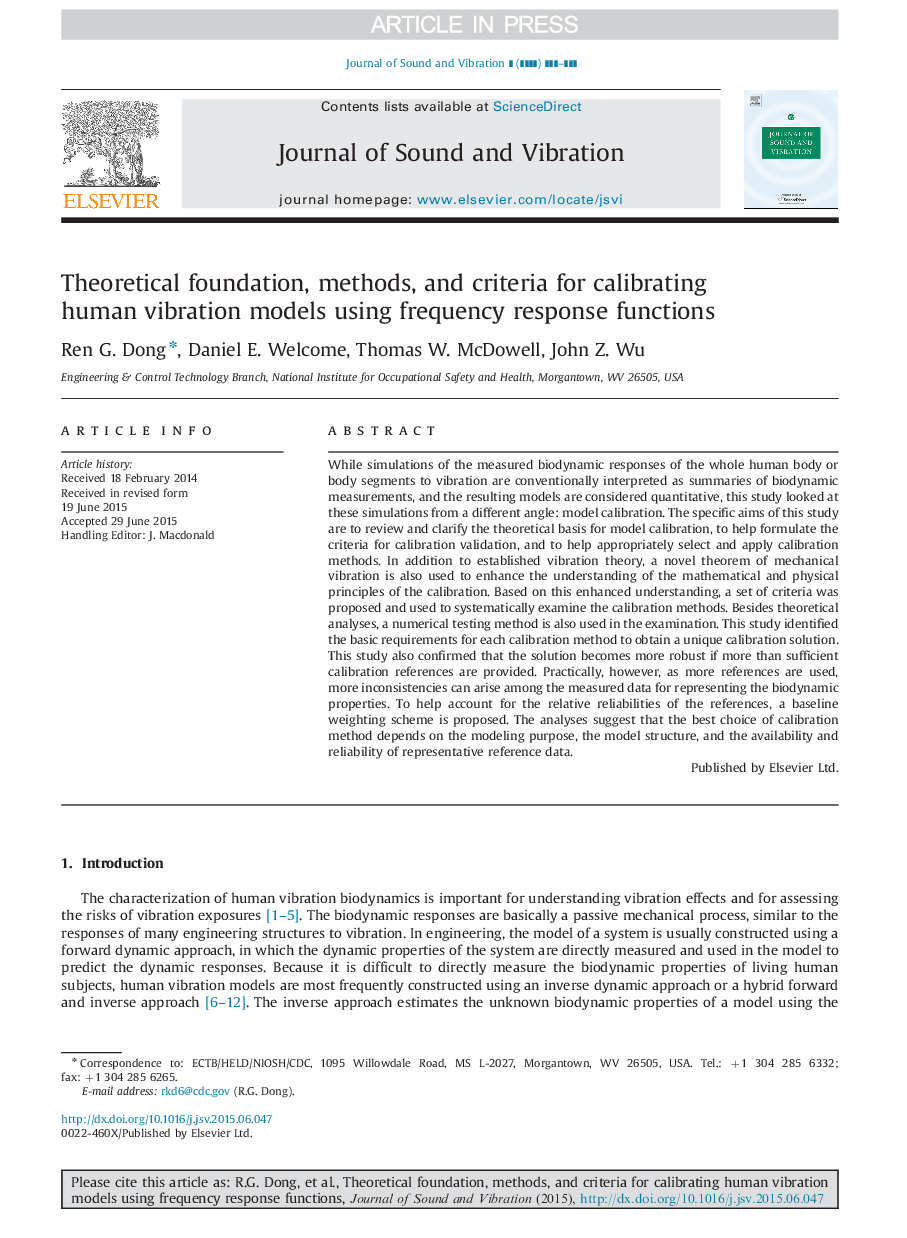| کد مقاله | کد نشریه | سال انتشار | مقاله انگلیسی | نسخه تمام متن |
|---|---|---|---|---|
| 6755321 | 509547 | 2015 | 22 صفحه PDF | دانلود رایگان |
عنوان انگلیسی مقاله ISI
Theoretical foundation, methods, and criteria for calibrating human vibration models using frequency response functions
ترجمه فارسی عنوان
مبانی نظری، روش ها و معیارهای کالیبراسیون مدل های ارتعاش انسان با استفاده از توابع واکنش فرکانس
دانلود مقاله + سفارش ترجمه
دانلود مقاله ISI انگلیسی
رایگان برای ایرانیان
ترجمه چکیده
در حالی که شبیه سازی پاسخ های اندازه گیری باندینامیکی بخش های بدن انسان و بدن به لرزش به طور خلاصه به عنوان خلاصه ای از اندازه گیری های بیودینامیکی تفسیر می شود و مدل های حاصل از آنها به صورت کمی در نظر گرفته می شوند. این مطالعه از این زوایا از یک زاویه متفاوت: کالیبراسیون مدل استفاده شده است. اهداف خاص این مطالعه بررسی و توضیح مبانی نظری کالیبراسیون مدل، کمک به فرمول کردن معیارهای اعتبارسنجی کالیبراسیون و کمک به مناسب انتخاب و اعمال روش های کالیبراسیون است. علاوه بر نظریه ارتعاش ثابت، قضیه جدیدی از ارتعاش مکانیکی نیز برای افزایش درک اصول ریاضی و فیزیکی کالیبراسیون استفاده می شود. بر اساس این درک پیشرفته، مجموعه ای از معیارها به منظور بررسی روش های کالیبراسیون به طور سیستماتیک مورد استفاده قرار گرفت. علاوه بر تجزیه و تحلیل های نظری، روش آزمون عددی نیز در معاینه مورد استفاده قرار می گیرد. این مطالعه تعیین الزامات اساسی برای هر روش کالیبراسیون برای به دست آوردن یک راه حل کالیبراسیون منحصر به فرد. این مطالعه همچنین تأیید کرد که اگر بیشتر از مراجع کالیبراسیون کافی ارائه شود، راه حل قوی تر خواهد شد. با این حال، عملا، به عنوان منابع بیشتر استفاده می شود، اختلافات بیشتر می تواند در میان داده های اندازه گیری برای نشان دادن خواص بیودینامیکی بوجود می آیند. برای کمک به حسابدهی نسبی ارجاعات، یک طرح وزن بندی اولیه پیشنهاد شده است. تجزیه و تحلیل ها نشان می دهد که بهترین انتخاب روش کالیبراسیون بستگی به هدف مدل سازی، ساختار مدل، و دسترسی و قابلیت اطمینان داده های مرجع نمایندگی است.
موضوعات مرتبط
مهندسی و علوم پایه
سایر رشته های مهندسی
مهندسی عمران و سازه
چکیده انگلیسی
While simulations of the measured biodynamic responses of the whole human body or body segments to vibration are conventionally interpreted as summaries of biodynamic measurements, and the resulting models are considered quantitative, this study looked at these simulations from a different angle: model calibration. The specific aims of this study are to review and clarify the theoretical basis for model calibration, to help formulate the criteria for calibration validation, and to help appropriately select and apply calibration methods. In addition to established vibration theory, a novel theorem of mechanical vibration is also used to enhance the understanding of the mathematical and physical principles of the calibration. Based on this enhanced understanding, a set of criteria was proposed and used to systematically examine the calibration methods. Besides theoretical analyses, a numerical testing method is also used in the examination. This study identified the basic requirements for each calibration method to obtain a unique calibration solution. This study also confirmed that the solution becomes more robust if more than sufficient calibration references are provided. Practically, however, as more references are used, more inconsistencies can arise among the measured data for representing the biodynamic properties. To help account for the relative reliabilities of the references, a baseline weighting scheme is proposed. The analyses suggest that the best choice of calibration method depends on the modeling purpose, the model structure, and the availability and reliability of representative reference data.
ناشر
Database: Elsevier - ScienceDirect (ساینس دایرکت)
Journal: Journal of Sound and Vibration - Volume 356, 10 November 2015, Pages 195-216
Journal: Journal of Sound and Vibration - Volume 356, 10 November 2015, Pages 195-216
نویسندگان
Ren G. Dong, Daniel E. Welcome, Thomas W. McDowell, John Z. Wu,
